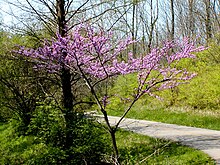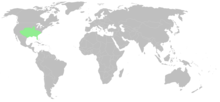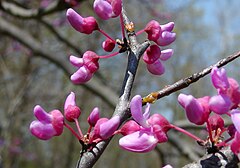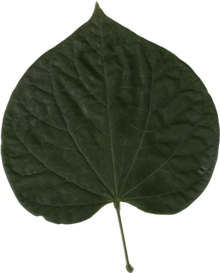
Hi Everybody!!
The Forest Pansy Redbud Tree pops out dark, wine-red leaves after the pink buds. Other Eastern Redbuds have green, heart shaped leaves. This dark knight stands out in the woodland landscape. For anyone who loves the deep purple hues in the garden, this tree will become your Spring Favorite! I have shared info below from Wikipedia about this lovely tree. Google Search has options to purchase these trees. I encourage everyone to plant trees like never before. You must water new trees at least every week for the first year. You will establish wind blocks and shade around your place. Living with trees is a great life! Enjoy!





https://plus.google.com/u/0/photos/117645114459863049265/albums/6000457449043579025


https://en.wikipedia.org/wiki/Cercis_canadensis
Cercis canadensis
From Wikipedia, the free encyclopedia
| Cercis canadensis | |
|---|---|
 | |
| Eastern redbud near Cincinnati, OH. | |
| Conservation status | |
| Scientific classification | |
| Kingdom: | Plantae |
| (unranked): | Angiosperms |
| (unranked): | Eudicots |
| (unranked): | Rosids |
| Order: | Fabales |
| Family: | Fabaceae |
| Genus: | Cercis |
| Species: | C. canadensis |
| Binomial name | |
| Cercis canadensis L. | |
 | |
 | |
| Natural range of the Eastern Redbud | |
Cercis canadensis (eastern redbud) is a large deciduous shrub or small tree,native to eastern North America from Southern Ontario, Canada south to northern Florida but can thrive as far west as California.
Description[edit]
It typically grows to 6–9 m (20–30 ft) tall with a 8–10 m (26–33 ft) spread. It generally has a short, often twistedtrunk and spreading branches. A 10-year-old tree will generally be around 5 m (16 ft) tall. The bark is dark in color, smooth, later scaly with ridges somewhat apparent, sometimes with maroon patches. The twigs are slender and zigzag, nearly black in color, spotted with lighter lenticels. The winter buds are tiny, rounded and dark red to chestnut in color. Theleaves are alternate, simple, heart shaped with an entire margin, 7–12 cm (3-5 inches) long and wide, thin and papery, and may be slightly hairy below.
The flowers are showy, light to dark magenta pink in color, 1.5 cm (½ inch) long, appearing in clusters from Spring to early Summer, on bare stems before the leaves, sometimes on the trunk itself. The flowers are pollinated by long-tongued bees such as blueberry bees and carpenter bees. Short-tongued bees apparently cannot reach the nectaries. The fruit are flattened, dry, brown, pea-like pods, 5–10 cm (2-4 inches) long that contain flat, elliptical, brown seeds 6 mm (¼ inch) long, maturing in August to October.
In some parts of southern Appalachia, green twigs from the eastern redbud are used as seasoning for wild game such as venison and opossum. Because of this, in these mountain areas the eastern redbud is sometimes known as the spicewood tree.
In the wild, eastern redbud is a frequent native understory tree in mixed forests and hedgerows. It is also much planted as a landscape ornamental plant. The leaves are eaten by the caterpillars of some Lepidoptera, for example the Io moth(Automeris io).
This tree is difficult to grow as far west as western Kansas and Colorado, as there is not sufficient water. Its far northern range of growth is southern New England. It grows well in New York State, New Jersey and southward.
- Bark: Red brown, with deep fissures and scaly surface. Branchlets at first lustrous brown, later become darker.
- Wood: Dark reddish brown; heavy, hard, coarse-grained, not strong. Sp. gr., 0.6363; weight of cu. ft. 39.65 lbs.
- Winter buds: Chestnut brown, obtuse, one-eighth inch long.
- Leaves: Alternate, simple, heart-shaped or broadly ovate, two to five inches long, five to seven-nerved, chordate or truncate at the base, entire, acute. They come out of the bud folded along the line of the midrib, tawny green; when they are full grown they become smooth, dark green above, paler beneath. In autumn they turn bright clear yellow. Petioles slender, terete, enlarged at the base. Stipules caduceous.
- Flowers: April, May, before and with the leaves, papilionaceous. Perfect, rose color, borne four to eight together, in fascicles which appear at the axils of the leaves or along the branch and sometimes on the trunk itself.
- Calyx: Dark red, campanulate, oblique, five-toothed, imbricate in bud.
- Corolla: Papilionaceous, petals five, nearly equal, pink or rose color, upper petal the smallest, enclosed in the bud by the wings, and encircled by the broader keel petals.
- Stamens: Ten, inserted in two rows on a thin disk, free, the inner row rather shorter than the others.
- Pistil: Ovary superior, inserted obliquely in the bottom of the calyx tube, stipitate; style fleshy, incurved, tipped with an obtuse stigma.
- Fruit: Legume, slightly stipitate, unequally oblong, acute at each end. Compressed, tipped with the remnants of the style, straight on upper and curved on the lower edge. Two and a half to three inches long, rose color, full grown by midsummer, falls in early winter. Seeds ten to twelve, chestnut brown, one-fourth of an inch long -can be made to germinate by first dipping in boiled (99C) water (very hot) for a minute and then sowing in a pot (do not boil the seeds); cotyledons oval, flat.[2]
Cultivation[edit]
C. canadensis is grown in parks and gardens, with several cultivars being available. The cultivar 'Forest Pansy', with purple leaves, has gained the Royal Horticultural Society's Award of Garden Merit.[3]
Edibility[edit]
Native Americans consumed redbud flowers raw or boiled, and ate roasted seeds. Analysis of nutritional components in edible parts of eastern redbud reported that:
- the flower extract contains anthocyanins,
- green developing seeds contained proanthocyanides, and
- linolenic, alpha-linolenic, oleic and palmitic acids to be present in seeds.[4]

https://plus.google.com/u/0/photos/117645114459863049265/albums/6000465039378063985


https://plus.google.com/u/0/photos/117645114459863049265/albums/6000470848097611249

https://plus.google.com/u/0/photos/117645114459863049265/albums/6000478557233509313







https://plus.google.com/u/0/photos/117645114459863049265/albums/6001263246763693857



...this is brendasue signing off from Rainbow Creek. See You next time!

O+O









No comments:
Post a Comment
Hi Everybody! Please say hello and follow so I know you are here! Due to the inconsideration of people trying to put commercials on my blog comment area, I have restricted use of anonymous posts. Sorry that some hurt all.
My public email is katescabin@gmail.com No spammers or trolls